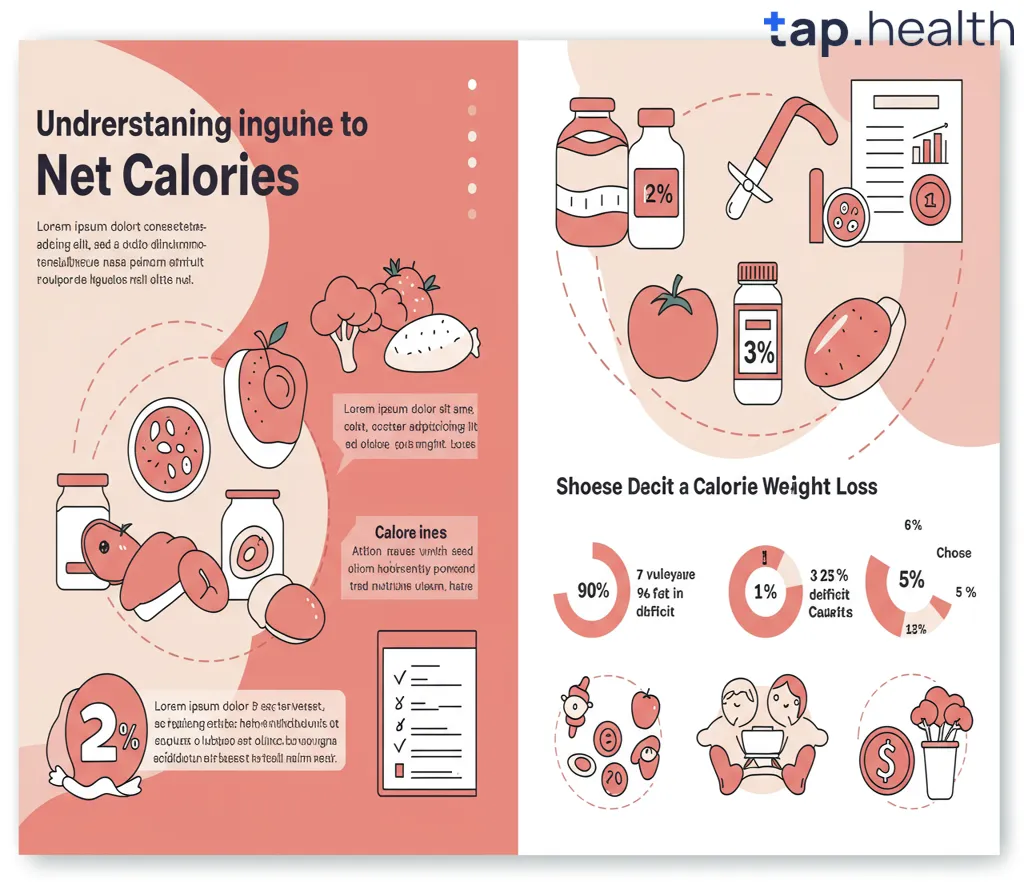Losing weight can feel like a complex task, but understanding the concept of net calories can make it simpler. Net calories are a critical part of any weight loss strategy. Whether you’re trying to shed a few pounds or make a more significant change to your body, understanding how to calculate and manage your net calories is a crucial first step.
In this guide, we will explore everything you need to know about net calories, how to calculate them, and how to use them effectively to lose weight. By the end of this article, you’ll have a clear understanding of how many net calories you need to consume to reach your weight loss goals.
What Are Net Calories?
Before we dive into how many net calories you need to lose weight, it’s important to understand what net calories actually are.
Definition of Net Calories
Net calories refer to the calories you consume from food and drinks, minus the calories you burn through physical activity. This number is crucial because it gives you a better picture of how many calories you are actually taking in versus burning each day.
In simple terms, Net Calories = Calories In – Calories Out (Exercise & Physical Activity).
Net calories play a major role in determining whether you will gain, lose, or maintain weight. If your net calories are positive, you are consuming more than your body is burning, which may lead to weight gain. If your net calories are negative, you are burning more than you are consuming, which leads to weight loss.
How Do You Calculate Net Calories?
Step 1: Determine Your Total Daily Energy Expenditure (TDEE)
To calculate your net calories, you need to first know how many calories your body needs each day to maintain your current weight. This is known as your Total Daily Energy Expenditure (TDEE).
TDEE is calculated by considering your Basal Metabolic Rate (BMR) and your activity level.
What Is Basal Metabolic Rate (BMR)?
Your BMR is the number of calories your body needs to perform basic functions like breathing, digesting food, and circulating blood. You can calculate your BMR using the Mifflin-St Jeor Equation:
- For men:
BMR=10×weight in kg+6.25×height in cm−5×age in years+5BMR = 10 \times \text{weight in kg} + 6.25 \times \text{height in cm} – 5 \times \text{age in years} + 5BMR=10×weight in kg+6.25×height in cm−5×age in years+5 - For women:
BMR=10×weight in kg+6.25×height in cm−5×age in years−161BMR = 10 \times \text{weight in kg} + 6.25 \times \text{height in cm} – 5 \times \text{age in years} – 161BMR=10×weight in kg+6.25×height in cm−5×age in years−161
Once you’ve determined your BMR, you can adjust it based on your activity level:
- Sedentary (little or no exercise): BMR x 1.2
- Lightly active (light exercise/sports 1-3 days/week): BMR x 1.375
- Moderately active (moderate exercise/sports 3-5 days/week): BMR x 1.55
- Very active (hard exercise/sports 6-7 days/week): BMR x 1.725
- Super active (very hard exercise or physical job): BMR x 1.9
For example, if your BMR is 1,800 calories and you’re moderately active, your TDEE would be: TDEE=1,800×1.55=2,790 calories/dayTDEE = 1,800 \times 1.55 = 2,790 \text{ calories/day}TDEE=1,800×1.55=2,790 calories/day
This means that to maintain your current weight, you need to consume around 2,790 calories each day.
Step 2: Track Your Caloric Intake
Next, you need to track how many calories you consume each day. This includes all the food and drinks you ingest, including snacks and liquids like juices or soda. Many apps, such as MyFitnessPal, make it easier to log your food intake and keep track of your daily calories.
Step 3: Track Your Physical Activity
In addition to knowing your caloric intake, you also need to calculate how many calories you’re burning through physical activity. You can estimate your calorie burn based on your exercise routine or use a fitness tracker to get a more accurate number.
Step 4: Subtract Exercise Calories from Total Calories In
Finally, subtract the calories burned through exercise from your total caloric intake to get your net calories.
How Many Net Calories Do You Need to Lose Weight?
To lose weight, you need to create a calorie deficit—that is, you need to burn more calories than you consume. But how many fewer calories should you eat each day to lose weight?
Creating a Calorie Deficit
A common approach to weight loss is to aim for a 500-calorie deficit per day, which leads to about 1 pound of weight loss per week. This is based on the fact that 3,500 calories equal approximately 1 pound of fat.
To achieve this:
- If your TDEE is 2,790 calories, you should aim for a net calorie intake of around 2,290 calories per day (2,790 – 500 = 2,290).
Gradual Weight Loss is Key
While a 500-calorie deficit is a good target, losing weight too quickly can lead to muscle loss and other health issues. Therefore, it’s important to aim for a sustainable and gradual weight loss process. A deficit of 250-500 calories per day is typically ideal for healthy, long-term weight loss.
What Is the Difference Between Net Calories and Gross Calories?
Many people confuse net calories with gross calories. Here’s the difference:
- Gross Calories: These are the total calories you consume without accounting for exercise or physical activity.
- Net Calories: These are the calories you consume after subtracting the calories burned through exercise and activity.
For example, if you eat 2,500 calories but burn 300 calories through exercise, your net calories for the day would be 2,200.
How Can You Adjust Your Net Calories for Faster Weight Loss?
If you want to accelerate your weight loss, you can either decrease your calorie intake or increase your physical activity.
Decrease Your Calorie Intake
To lose weight faster, you can reduce your net calories further. However, cutting too many calories can be harmful, leading to nutrient deficiencies, fatigue, and muscle loss. Aim to reduce calories by no more than 500-1,000 per day for safe and sustainable weight loss.
Increase Your Physical Activity
By increasing your physical activity, you can burn more calories, which will increase your calorie deficit. This could include adding extra exercise sessions or increasing the intensity of your workouts. Cardio activities like running, cycling, and swimming are great for burning calories, while strength training can help you build muscle and boost your metabolism.
How to Track and Maintain Your Net Calories
Tracking your calories effectively is key to weight loss success. Here are some tips for tracking and maintaining your net calories:
Use a Calorie Tracker
Apps like MyFitnessPal or Lose It! can help you log your food intake and track your exercise. These apps can automatically calculate your net calories and help you stay on track with your weight loss goals.
Be Consistent
Consistency is key to weight loss. Track your calories every day to ensure you’re staying within your calorie deficit. Even small slips can add up over time.
Adjust as Needed
If you’re not losing weight, you may need to adjust your calorie intake or increase your physical activity. If you’re losing weight too quickly, you might want to add a few more calories to your diet to avoid muscle loss and other health problems.
Frequently Asked Questions (FAQs) on How Many Net Calories to Lose Weight? A Complete Guide
How Many Net Calories Should I Eat to Lose Weight?
To lose weight, you need a calorie deficit. A typical starting point is reducing your net calorie intake by 500–1,000 calories per day, which can lead to about 1–2 pounds of weight loss per week.
What’s the Difference Between Net Calories and Total Calories?
Net calories are the total calories consumed minus the calories burned through physical activity. Total calories refer to all the calories you eat without factoring in exercise or activity.
Can I Lose Weight with a Low Net Calorie Intake?
Yes, you can lose weight with a low net calorie intake, but it’s important not to go too low. A deficit of 500-1,000 calories per day is generally recommended for safe and sustainable weight loss.
How Can I Create a Calorie Deficit Without Starving Myself?
To create a calorie deficit without starving yourself, focus on eating nutrient-dense foods that keep you full and satisfied. Include lean proteins, whole grains, healthy fats, and lots of fruits and vegetables in your diet. You can also increase your physical activity to help burn more calories.
How Long Does It Take to See Results?
With a consistent calorie deficit, you may begin to see results in 1-2 weeks, although it can take longer to notice significant changes in body composition. Remember, weight loss is a gradual process, and consistency is key.
In conclusion, understanding and managing your net calorie intake is a fundamental part of any weight loss journey. By tracking both your calories consumed and calories burned through activity, you can create a healthy calorie deficit that promotes steady, sustainable weight loss. Keep it simple, stay consistent, and adjust your approach as needed to reach your weight loss goals.



